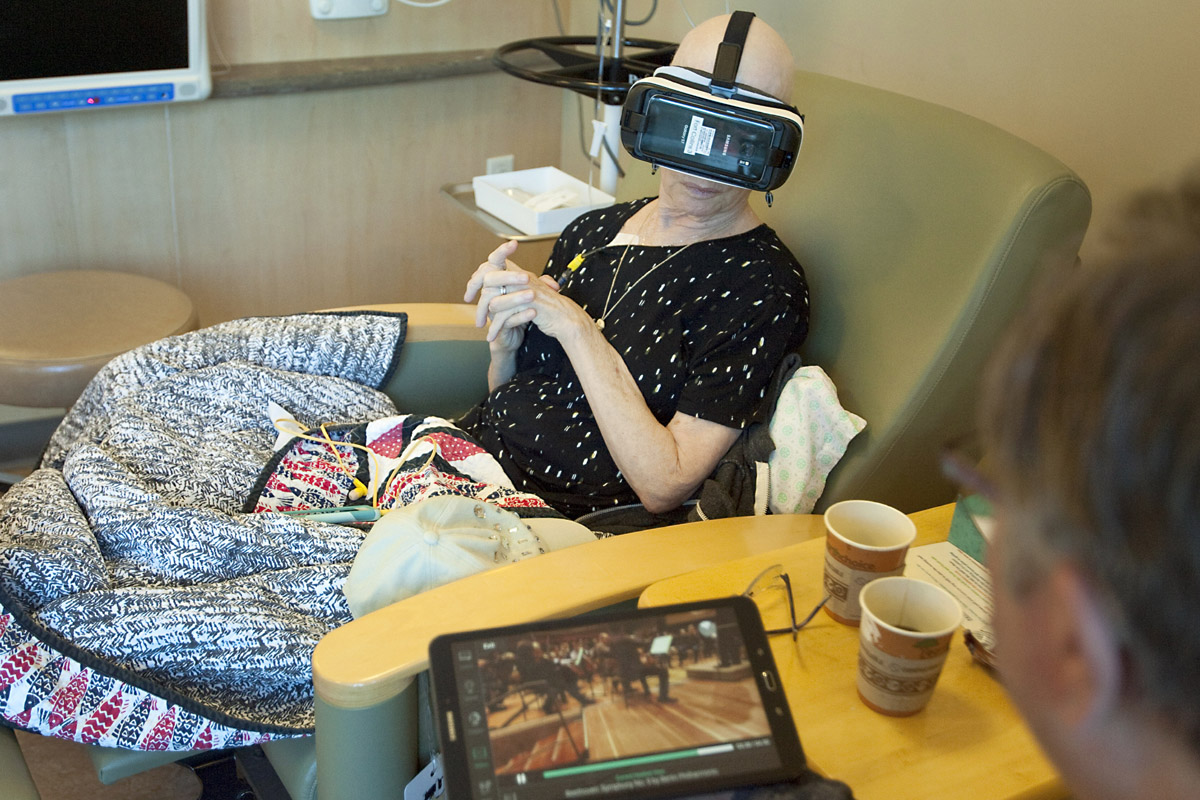During chemotherapy, Mary Hill watches a short virtual reality video that puts her in her favorite seat at a symphony – right next to the violinists — while her husband, John Hill, watches on a tablet. Photos by Joel Blocker, for UCHealth.
UCHealth uses the power of technology to transform the patient experience.
Mary Hill took off her knitted cap and placed the strap for the virtual reality goggles over her smooth head. She motioned to her husband, John, and asked him to select the symphony video on the tablet he was holding.
“We’ve been to Symphonic Hall in Paris twice,” she said. “Oh, the acoustics, the music and the world-class musicians.”
The virtual reality video begins and a smile comes over Mary’s face.
“They put me in the best spot,” she said. “Right next to the violinists.”
Offering virtual reality for patients who are receiving infusion therapy is one of the ways that UCHealth is aiming to enhance the patient experience.
“Virtual reality has been used in health care for a couple decades now,” said Nicole Caputo, UCHealth’s director of experience and innovation. “We read the literature and research on its benefits and decided it was something we should see if our patients would benefit from.”
In health care, VR is being used for pain management, to combat loneliness in long-term care facilities and for clinical education. Virtual reality is also popular in gaming and the construction industry to showcase proposed designs.
Since infusion patients often spend hours sitting in one spot while they receive treatment, UCHealth started a trial for VR in the infusion centers.
“We wanted to see if using virtual reality as a distraction improved our patient experience,” Caputo said.
The results were overwhelmingly positive.
The pilot program
A poll of 18 caregivers, 60 patients and 18 staff members who provide care for those patients found that 88 percent of patients who tried VR said they’d use it again, as did 94 percent of caregivers.
“We learned it was a distraction, but we kind of knew that,” Caputo said. “But what we learned that we didn’t know going in was that it’s so much more than a distraction. For patients, it made time go faster and transported them to a new place — some even said they forgot they were sick for a bit.
“The best part is that it’s simple — it makes people happy. And if we can do that while they are here, that’s what we want to do. That’s what makes this technology so powerful; it has the power to transform your experience.”
Expanding VR in health-care facilities
With data to back the plan, UCHealth chose 10 locations to roll out VR at outpatient cancer care and infusion facilities throughout the Front Range and Steamboat Springs.
Chuck Kler was one of the first patients in northern Colorado to use VR. He gets blood work done several times a week and must wait for the results before knowing if he’ll need to stay longer for a blood transfusion. He enjoys VR and said it breaks up the monotony of doing the same thing each time he comes.
“It’s fascinating,” he said. “And I’ve got my favorites already.”
UCHealth partnered with Rendever, a Boston-based company that originally created its programs and equipment for long-term care facilities. The equipment includes a set of goggles that fit a Samsung smartphone. The phone is linked to a tablet, which controls the program. Participants can choose from games or different short videos — such as swimming with dolphins — or they can even drop themselves into their old neighborhood in a Google-Maps-like experience.
Kler likes the farm sanctuary video — a favorite among most participants, who have commented on liking everything from the “goats that jump in my lap” to the video’s “happy ending.”
Participants can take a helicopter flight over Dubai, lounge with seals, or sit in the audience of a symphony. There are even localized materials including cycling through the mountains or touring Garden of the Gods in Colorado Springs.
This article was first published in October 2018 at UCHealth Today. Read more inspiring articles and health care news at www.uchealth.org/today.
